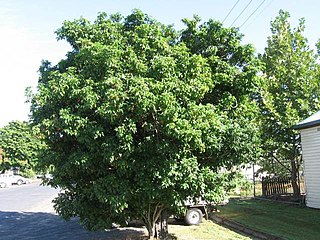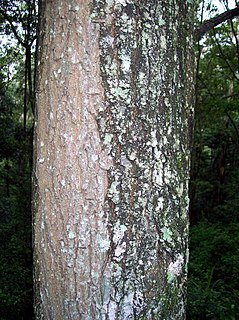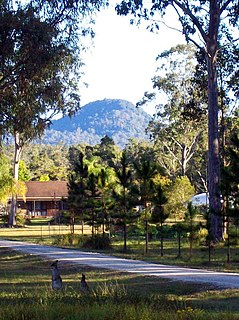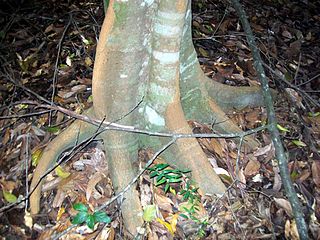
Endiandra is a genus of approximately 100 species of plants, mainly trees, in the laurel family Lauraceae. They are commonly called "walnut" despite not being related to the Northern Hemisphere walnuts which are in the family Juglandaceae.

Doryphora sassafras, commonly known as sassafras, yellow-, canary- or golden sassafras, or golden deal, is a species of evergreen tree of the family Atherospermataceae native to the subtropical and temperate rainforests of eastern New South Wales and Queensland, Australia. It is a tall tree with green foliage and contrasting white flowers which occur in Autumn and Winter.

Endiandra globosa is a medium-sized Australian rainforest tree. Despite the common name of black walnut, this tree is unrelated to northern hemisphere walnuts, and is a Laurel.

Alexander Geoffrey Floyd is an Australian botanist with an expert knowledge of rainforest plants, particularly the rainforest trees of New South Wales. He has worked with the New South Wales Forestry Commission, the Department of Forestry in Papua-New Guinea, and the National Parks and Wildlife Service of New South Wales. He helped create the North Coast Regional Botanic Garden at Coffs Harbour. Two genera and several species of plants are named in his honour; including Floydia, Alexfloydia, and Endiandra floydii.

Cryptocarya foveolata, known as the mountain walnut is a rainforest tree growing at high altitude in eastern Australia. Despite the common name, it belongs to the laurel family.

Endiandra pubens is a rainforest tree growing in eastern Australia. The habitat is subtropical rainforest growing near streams in valleys. The range of natural distribution is from the Bellinger River, New South Wales to Bulburin National Park, south west of Gladstone, Queensland.

Croton verreauxii known as the green native cascarilla is a small tree or shrub growing in dry rainforest and rainforest margins in eastern Australia.

Endiandra discolor is an Australian tree, growing from near Gosford, New South Wales to Tully, Queensland in the tropics. Common names include rose walnut and domatia tree.

Endiandra virens is an Australian tree in the laurel family. Growing from Boorganna Nature Reserve north west of Taree, New South Wales to Kin Kin in Southern Queensland. Common names include White Apple, Plumwood, and New South Wales Walnut.

Numinbah Nature Reserve is a protected nature reserve that is located in the Northern Rivers region of New South Wales, in eastern Australia. The reserve was gazetted in December 1981 with a further addition made in 1989 to make the reserve to its current area of 858 hectares. The reserve is situated north-east of the rural locality of Numinbah, and south of the Queensland town of Springbrook and defines part of the state border between New South Wales and Queensland.

Harpullia pendula, known as the tulipwood or tulip lancewood is a small to medium-sized rainforest tree from Australia. The tree's small size, pleasant form and attractive fruit ensures the popularity of this ornamental tree. The range of natural distribution is from the Bellinger River in northern New South Wales to Coen in tropical Queensland. Tulipwood occurs in various types of rainforest, by streams or dry rainforests on basaltic or alluvial soils. In tropical and sub tropical rainforest. Often seen as a street tree, such as at St Ives, New South Wales.

Bridelia exaltata, known as the brush ironbark or scrub ironbark, is a tree of eastern Australia. It occurs in and on the margins of the drier rainforests. Also occurring by streams, often in association with the Black Bean, up to an elevation of 600 metres above sea level. It occurs from Seal Rocks, New South Wales to Maryborough, Queensland.

Cryptocarya floydii is an Australian rainforest tree. It occurs in steep dry rocky gullies in northern New South Wales and adjacent areas in Queensland as far north as Bunya Mountains National Park. It grows as far south as the upper gullies of the Guy Fawkes River and the Macleay River. The common name is gorge laurel or Glenugie laurel, after the type locality of Glenugie Peak, near Grafton, New South Wales.

Endiandra hayesii is an Australian rainforest tree. Despite the common name of rusty rose walnut, this tree is unrelated to northern hemisphere walnuts, and is a laurel. The former habitat is lowland sub tropical rainforest, most of which has been cleared. However some trees persist in cool sheltered gullies as far south as the Richmond River, New South Wales to just over the border at Burleigh Heads in Queensland. The rusty rose walnut is considered rare, with a ROTAP rating of 3RC-. It is named after H.C. Hayes, who collected this species at Minyon Falls.

Fontainea australis is a rare rainforest plant from eastern Australia. The common name is southern fontainea. It grows in sub tropical rainforest at low altitudes on basaltic alluvial soils. Distributed from the Wilsons River to the Tallebudgera Valley in south eastern Queensland.

Endiandra introrsa is a rare rainforest tree growing in eastern Australia. Listed with a Rare or Threatened Australian Plants (ROTAP) rating of 3RCa. Its habitat is warm temperate rainforest on the poorer rainforest soils, mostly over 300 metres in altitude, and its range of natural distribution is from near Dorrigo to various sites in the state of Queensland.

Endiandra muelleri subsp. bracteata, is a rare rainforest tree growing in eastern Australia. Listed as endangered by extinction. It is a subspecies of the tree known as green-leaved rose walnut, or Mueller's walnut, Endiandra muelleri. It occurs from Maclean, New South Wales to Mackay, Queensland, usually in sub tropical rainforest at the lower altitudes.

Endiandra muelleri is a rainforest tree of eastern Australia. Its habitat is in warm temperate rainforests on poorer soils. Distributed from the Allyn River in the Barrington Tops region in the south to Kroombit Tops to the north in central Queensland.

Alangium villosum subsp. polyosmoides is a rainforest tree of eastern Australia. It occurs on a variety of different soils and rainforests, relatively close to the coast. Found from Minmi near Newcastle to as far north as the McIlwraith Range in far north eastern Australia. It may be seen as a common understorey plant at Wingham Brush Nature Reserve.

Bosistoa floydii, commonly known as the five-leaf bosistoa or five-leaved bonewood, is a species of small rainforest tree that is endemic to north-eastern New South Wales. It has pinnate leaves usually with five elliptic leaflets, and panicles of tiny, creamy white flowers.






















